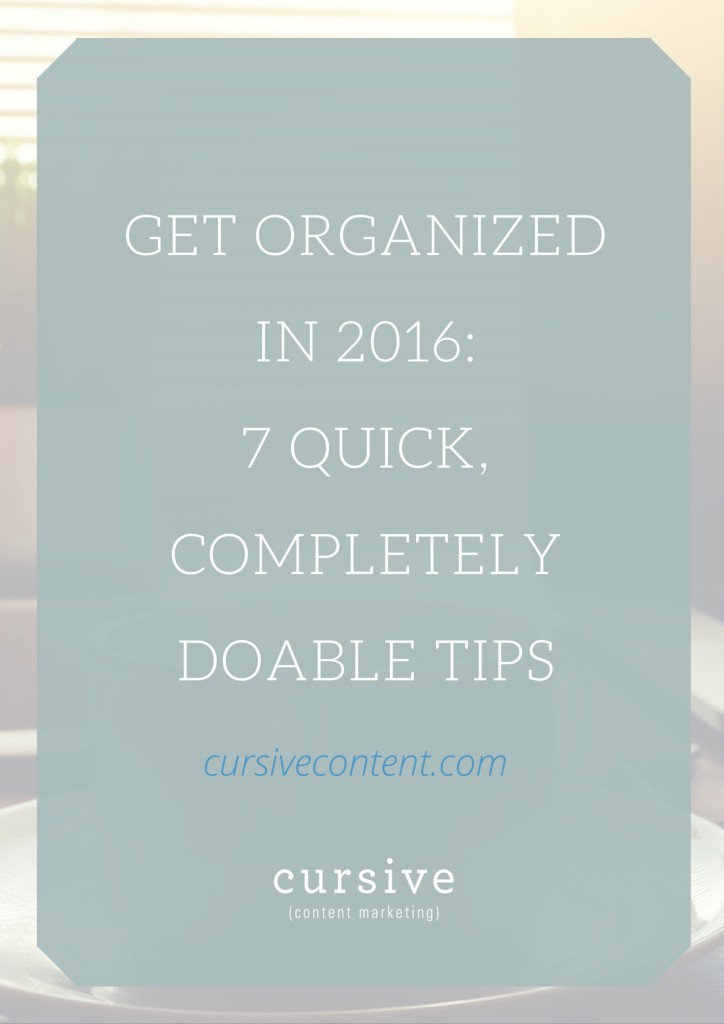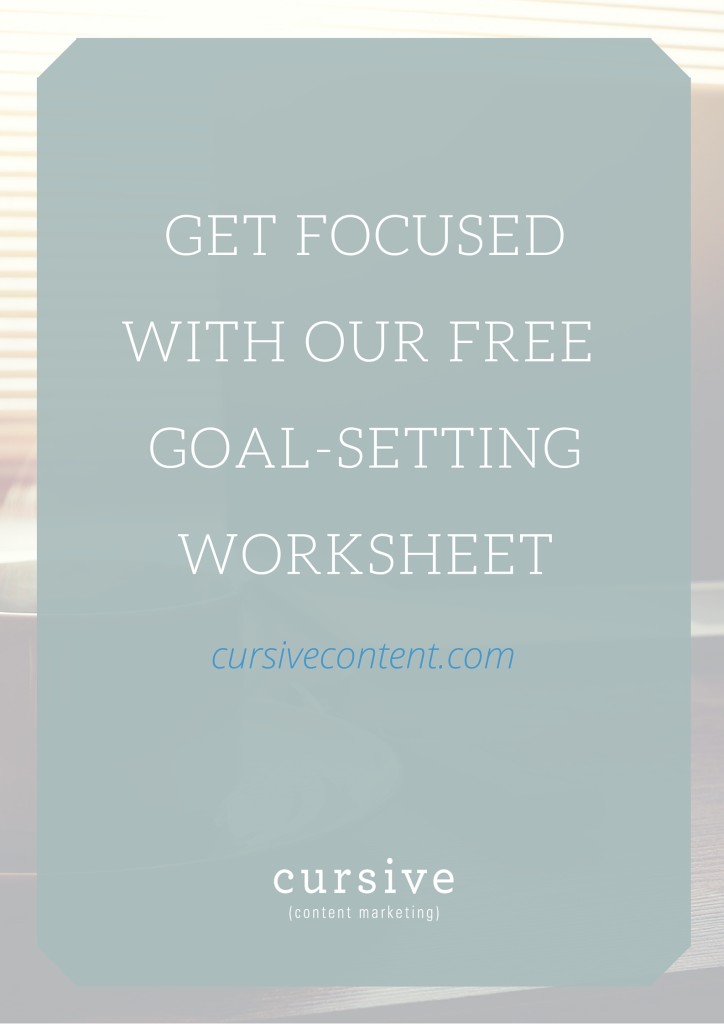Get Organized in 2016: 7 Quick, Completely Doable Tips
Ah, the holidays.
To-do lists pile up (nothing gets crossed off). Menus are planned (and more lists are made). Cleaning gets done (then, too quickly, undone). Work gets pushed aside until next year (and there was already a lot there, not-so-patiently waiting to get done).
The hectic fun of the holidays is amazing and makes me feel so, so blessed. But honestly, I also look forward to getting back into the routine; I embrace the approach of the new year as a chance to get it together and start fresh.
For me, the most important step to starting 2016 on the right foot is creating systems and methods to get and stay organized all year long.
Here are 7 simple tips, tricks and tools (including an anecdote from the hyper-successful Warren Buffet) to help you get it all done and keep your sanity.

Start using Google Drive
This is especially useful for entrepreneurs, freelancers and anyone who works with others from multiple locations. With Google Drive, everyone can access a document and make edits, avoiding version control issues and confusion about who has the latest file.
Set up a news aggregation tool
We mention this one often—but that just shows how much we believe in it. A news aggregator like Feedly brings together all the things you love to read, all in one place. When you find a new resource you like, you can simply add it to your Feedly and move on.
Organize your inbox
Create folders. Delete old messages. Filter enewsletters into a separate tab or folder to be read when you choose. These small changes can do wonders for productivity.
I have a completely Type A relationship with my inbox. Anything that’s in my inbox is something I need to respond to or requires action on my part. Everything else is filed or deleted. This keeps me sane and organized, and I highly recommend a similar approach.
Buy (and use!) a printed planner
I know, I know—there’s an app for that. But there is something about a more tangible to-do list that helps visualize work load and get things done. Its physical presence also serves as a reminder to jot things down and check on what you’ve already written. There are no extraneous distractions like there are when you use your phone as a planner. Plus, is there anything more satisfying than checking something off a to-do list?
Make like Elsa and let it go
Magazine articles from last spring. Old emails. Business cards that are out-of-date. Toss ‘em. The more stuff you hang on to, the more cluttered your work space is. The more cluttered your workspace is, the more cluttered your mind is. Ditch the pack rat mentality and get rid of anything that isn’t serving you a real purpose.

Focus on priorities
I recently heard an anecdote about Warren Buffet that I think speaks perfectly to the quest to prioritize and achieve goals.
Buffet asked Mike, a long-time employee of his, to write down his top 25 career goals. Then, Buffet asked him to indicate his top five goals. Mike did, and told Buffet he would start working on those five things immediately.
Buffet then asked Mike what he planned to do about the rest of the goals on his list, the ones that didn’t make it to the top five. Mike replied that they were still important to him, so he would work on them occasionally, when he could fit them in. Because, while they weren’t the most important thing, they were still significant and he still wanted to dedicate time and effort to them.
Buffet replied, “No. You’ve got it wrong, Mike. Everything you didn’t circle just became your Avoid-At-All-Costs list. No matter what, these things get no attention from you until you’ve succeeded with your top five.”
Is it any wonder that Warren Buffett is one of the wealthiest and most successful men in the world? This story, and Buffett’s philosophy, are now tacked up on my bulletin board.
Love this approach? Download our goals worksheet to help guide you through it.
Write down your goals – in a different way
Moment of truth: I kind of hate writing goals or setting resolutions for myself. It feels kind of cheesy and inauthentic, even when it’s done in earnest. Not to mention that failure seems baked in to any decision made simply because it’s a new year.
So last year, I decided to take a different approach—one that I will continue for 2016. Instead of setting goals or resolutions, I started by writing down eight areas of my life that I wanted to make an impact in. I then wrote a guiding statement, that I called a mantra, for each.
I know the word “mantra” can sound just as cheesy as resolution, but it worked for me. My mantras are very short, simple statements that I easily memorized and could say in my head whenever a situation arose.
For example, in 2014 I was struggling with balancing the responsibilities of work, home and caring for my then 1-year-old daughter. On some days, I felt like I was letting trivial work and housekeeping distractions take away from my time with her. So my 2015 mantra related to my daughter was simple: Be here now. It not only reminded me to be present, it reminded me that when I was with her, being present was my most important responsibility.
With other mantras for work, home, finances, marriage and friendships, I was able to constantly remind myself of the priorities I set for myself. Really, those priorities were goals, just reframed. While I can’t say I executed these mantras perfectly, they were incredibly helpful and helped lead me to create a great year for myself. I hope they can do the same for someone else.
Set goals and priorities for the year ahead with our goals worksheet. Get it now.
MORE ARTICLES
-
 Clarity in 50 Words or Less: How to Write Your School’s One-Sentence Story
Clarity in 50 Words or Less: How to Write Your School’s One-Sentence Story -
 What Should Your School Do with Its Blog Now That AI Is Changing Search?
What Should Your School Do with Its Blog Now That AI Is Changing Search? -
 What Is Your Private School’s Bold & Unifying Big Promise?
What Is Your Private School’s Bold & Unifying Big Promise? -
 AI Writing Prompts to Power Private School Storytelling
AI Writing Prompts to Power Private School Storytelling -
 When to Outsource Your Private School Content Marketing to an Expert
When to Outsource Your Private School Content Marketing to an Expert -
 3 Unique Ways to Attract Dream Families with Content
3 Unique Ways to Attract Dream Families with Content -
 4 Quick & Easy Ways to Improve Your School’s Emails
4 Quick & Easy Ways to Improve Your School’s Emails -
 The Best Content Marketing Resources for Independent Schools
The Best Content Marketing Resources for Independent Schools
